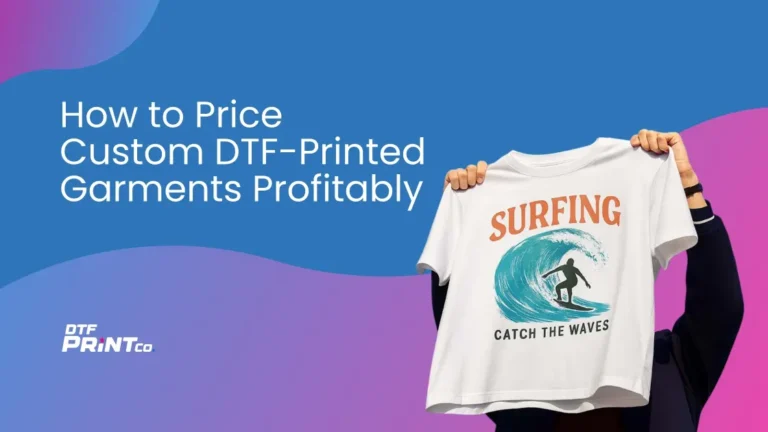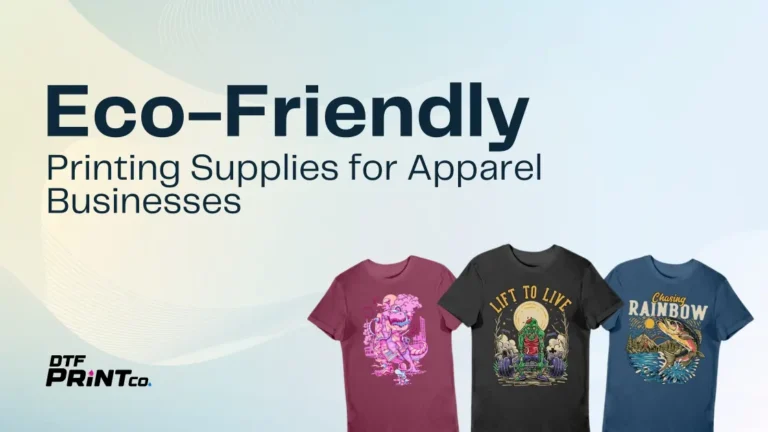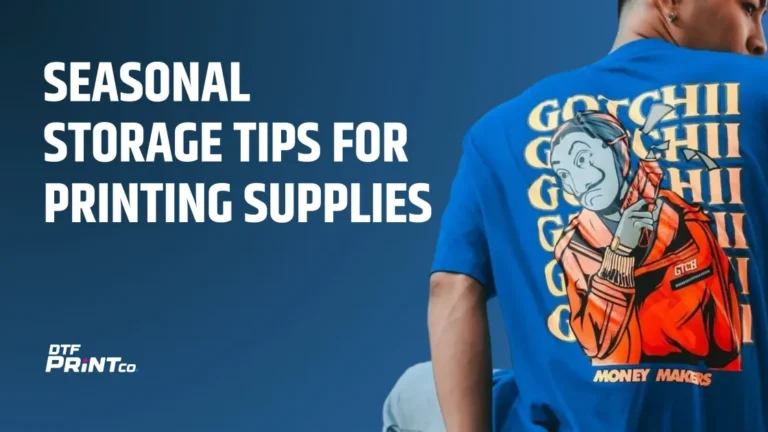Direct-to-Film (DTF) printing has become one of the fastest-growing trends in custom apparel and merchandise. Its flexibility, vibrant colors, and ability to work on different fabrics make it highly profitable for small businesses and print-on-demand sellers. But while many focus on the printing process, the real profit comes from creating high-quality, market-ready designs.
In this guide, you’ll learn how to create profitable DTF designs in Canva—a beginner-friendly design tool that doesn’t require advanced graphic design skills. We’ll break down the process step by step, explore best practices, and share strategies to help you turn simple ideas into sellable products.
What is a DTF Design?
A DTF design is a digital artwork created specifically for Direct-to-Film printing, a process where designs are printed on special transfer films and then applied to fabric using heat and pressure.
Unlike screen printing or sublimation, DTF can:
- Print on almost any fabric type (cotton, polyester, blends, dark or light colors)
- Capture fine details with vibrant, long-lasting colors
- Eliminate the need for pretreatment on garments
When you design for DTF, the goal is to produce artwork that:
- Has clean edges and high resolution
- Uses transparent backgrounds for easy transfer
- Matches popular trends or niche markets to increase sales potential
For entrepreneurs, the design phase is where profitability begins. A well-crafted Canva design can become a best-selling t-shirt, tote bag, or hoodie
How to Create Profitable DTF Designs in Canva
Creating profitable DTF designs is about blending artistic creativity with market-driven strategy. Canva makes this easier by offering professional-quality tools without needing Photoshop-level expertise. Below, we’ll walk through each critical step in detail, from concept to print-ready file.
Step 1: Research Profitable Niches
Before you open Canva, you need clarity on who you are designing for. A profitable design begins with demand.
Ways to research niches:
- Etsy Search Bar: Type in keywords like “t-shirt” + [theme] (e.g., “teacher t-shirt”) and see auto-suggestions. These reflect real buyer intent.
- Pinterest Trends: Browse seasonal or lifestyle boards to discover trending aesthetics.
- Google Trends: Identify growing interest in topics (e.g., “cottagecore shirts” or “retro Y2K designs”).
- Social Media: TikTok and Instagram hashtags (#customtshirts, #smallbusinessmerch) highlight what’s trending in fashion and gifts.
Examples of profitable DTF niches:
- Small businesses needing branded apparel
- Event-based designs (bachelorette parties, family reunions)
- Seasonal themes (Christmas, Halloween, Summer)
- Hobby-focused markets (fishing, gaming, yoga)
- Positive quotes or faith-based designs
Pro Tip: Stick with evergreen niches (teachers, pets, motivation) for steady sales, but also release seasonal/viral designs for quick profits.
Step 2: Define Your Canvas Size in Canva
DTF prints require high-resolution files to avoid blurry or pixelated results. Canva’s custom size feature is perfect for this.
- Go to Create a Design > Custom Size
- Use 4500 x 5400 pixels (standard POD t-shirt size used by Printful, Printify, etc.)
- Make sure orientation is vertical for apparel designs
- Leave extra space around the edges for flexible placement on shirts or hoodies
Why this matters: DTF printers often reject low-resolution files. A pixelated design can ruin the print and lead to refunds. By using a large canvas, you ensure crisp details—even if the design gets scaled.
Master Canva Design Techniques
Canva provides endless creative options, but not all styles work well for DTF printing. Here’s how to design with profitability in mind:
Typography That Sells
- Use bold, clean fonts for slogans (Sans-serif, Varsity, Block letters).
- Keep text short and readable from a distance.
- Combine 2–3 fonts max for balance (e.g., script + block).
- Use Canva’s curved text tool for retro or badge-style logos.
Example: A seller created a “Best Dog Mom Ever” design using a playful handwritten font with paw-print icons. It became a repeat bestseller in the pet niche.
Smart Use of Graphics
- Choose vector-style graphics from Canva Elements—they scale well for printing.
- Avoid overly thin lines or fine details (they can break during transfer).
- Use silhouette icons (animals, tools, hobbies) to pair with text-based designs.
- Stick to solid colors rather than photo-realistic images for easier transfer.
Example: A camping-themed hoodie combined a mountain silhouette with the phrase “Adventure Awaits” in bold text. Simple, clean, and highly marketable.
Color Palettes That Pop
- DTF shines with vivid, high-contrast colors.
- Use Canva’s Color Palette Generator to create unique brand styles.
- Keep designs to 3–5 main colors for versatility.
- For dark shirts → use bright/neon tones.
- For light shirts → use darker outlines and bold contrasts.
Pro Tip: Always preview your design on both black and white backgrounds in Canva to ensure versatility.
Step 4: Prepare Print-Ready Files
Once your design looks great, you need to export it correctly. Wrong settings = wasted prints.
Steps in Canva:
- Go to Download > PNG
- Select Transparent Background (Canva Pro feature)
- Enable 300 DPI resolution (essential for crisp prints)
- Avoid unnecessary effects like shadows or gradients, which may print inconsistently
Why PNG? PNG preserves transparency and high quality, while JPEG would add unwanted backgrounds and reduce resolution.
Step 5: Test Before You Sell
Don’t rush into bulk printing. Test your design digitally and physically.
- Mockups in Canva or Placeit: Upload your PNG to see how it looks on t-shirts, hoodies, or tote bags.
- Small-batch printing: Order 1–2 samples from a DTF transfer supplier before adding the design to your online store.
- Get feedback: Share mockups in Facebook groups or TikTok for reactions.
Example: A seller noticed that her neon design looked amazing on-screen but was too bright on fabric. Adjusting to a darker gradient improved final sales.
Step 6: Align with Profitability
Design alone doesn’t guarantee sales. Consider these profit-focused strategies:
- Bundle designs into packs (e.g., 5 motivational quotes for gym wear).
- Upsell merchandise: Offer the same design on mugs, tote bags, and stickers.
- Price smartly: Factor in printing + shipping costs; most DTF shirts sell between $19.99–$29.99.
- Leverage Canva templates: Reuse your layout with different slogans to quickly build a product catalog.
Key Takeaway: Canva makes it simple to create professional-quality DTF designs—but true profitability comes from choosing the right niche, ensuring print quality, and aligning designs with buyer demand.
Tips, Insights, and Strategies for Profitable DTF Designs in Canva
Once you’ve mastered the basics of creating DTF-ready files in Canva, the next step is turning your designs into consistent profit. This requires not only design skills but also marketing awareness, production efficiency, and quality control. Below are practical tips and advanced insights to help you scale.
Practical Tips for Profitable DTF Design
Keep Designs Simple but Impactful
- Minimalist designs often outsell complex ones because they’re versatile.
- A bold word or symbol can be more appealing than a crowded graphic.
- Example: A simple “Support Local Farmers” design with rustic typography became a best-seller on tote bags.
Create Variations for Multiple Audiences
- Adapt one design to different niches.
- Example: A “Proud Mom” shirt can be repurposed into “Proud Dad,” “Proud Teacher,” or “Proud Coach.”
- Saves time while multiplying revenue streams.
H3: Test Different Print Sizes and Placements
- Not all designs need to be centered chest prints.
- Try pocket-size logos, sleeve prints, or oversized back graphics.
- Canva’s resizing tool makes experimenting quick and easy.
H3: Use Canva Brand Kits for Consistency
- If you’re building a brand, use Canva Pro’s Brand Kit to store colors, fonts, and logos.
- This creates a recognizable style, improving customer loyalty.
H3: Combine Canva with Other Tools
- Remove.bg for advanced background removal
- Placeit for realistic product mockups
- EtsyRank / Marmalead for keyword research
- Figma/Illustrator (if you want finer edits beyond Canva’s scope)
Pros and Cons of Designing DTF Prints in Canva
Here’s a clear breakdown of Canva’s strengths and limitations for DTF sellers:
| Advantages |
Limitations |
| Easy to use, beginner-friendly |
Limited advanced editing tools compared to Photoshop |
| Affordable (free plan available; Pro is low-cost) |
Requires Pro for transparent background exports |
| Huge library of fonts, elements, and templates |
Some Canva elements are not for commercial use (must check license) |
| Cloud-based, accessible on any device |
Internet required for editing |
| Quick design turnaround for trend-driven niches |
May lack uniqueness if using stock templates without customization |
Verdict: Canva is excellent for beginners and entrepreneurs who value speed and accessibility. However, those scaling into larger brands may eventually pair it with professional software for advanced features.
Real-Life Examples of Profitable Canva DTF Designs
Case Study 1: Etsy Seller – Retro Quotes
A small Etsy seller created a line of retro-style motivational quotes using Canva’s curved text + vintage backgrounds. By targeting “70s aesthetic shirts,” they reached a niche audience and quickly generated consistent sales.
Case Study 2: Local Business Apparel
A small-town coffee shop used Canva to design branded tote bags and staff t-shirts. Since Canva allowed easy customization, the shop owner could refresh seasonal merch without hiring a designer, saving costs and increasing local sales.
Case Study 3: Viral Social Media Merch
A TikTok creator used Canva to design a funny slogan shirt that matched their trending video. By uploading a transparent PNG design to a DTF supplier and offering it to fans, they sold 200+ units in just two weeks.
Key Insight: Canva’s speed and simplicity allow entrepreneurs to capitalize on fast-moving trends, a huge advantage in the DTF market.
Frequently Asked Questions (FAQs)
Q1: Can I really make money selling DTF designs made in Canva?
Yes. Canva’s ease of use and DTF’s flexibility make it possible for beginners to launch profitable apparel businesses with minimal upfront costs.
Q2: What file format is best for DTF printing?
The best format is PNG with a transparent background at 300 DPI to ensure crisp, print-ready results.
Q3: Do I need Canva Pro to make DTF designs?
Technically no, but Canva Pro is highly recommended because it allows you to export transparent backgrounds and high-resolution files—both critical for DTF.
Q4: How do I avoid copyright issues with Canva elements?
Always check Canva’s Content License Agreement. Use only elements marked for commercial use, or create original designs by combining fonts, shapes, and graphics.
Q5: What are the most profitable niches for DTF designs?
Evergreen niches include pets, family roles (mom/dad/teacher), fitness, seasonal holidays, and inspirational quotes. Trend-driven niches like memes or TikTok trends can also spike profits.
SEO Title
How to Create Profitable DTF Designs in Canva: Step-by-Step Guide for Beginners
Meta Description (≤150 characters)
Learn how to create profitable DTF designs in Canva with step-by-step tips, niche ideas, and print-ready strategies for beginners.
Google Index-Friendly URL Slug
/profitable-dtf-designs-in-canva
Short Image Alt Text
DTF design created in Canva on a t-shirt mockup
Suggested Image URL
https://yourdomain.com/images/dtf-designs-canva-guide.jpg
H1 Heading
How to Create Profitable DTF Designs in Canva



